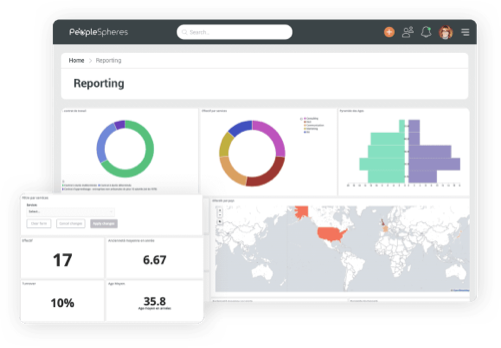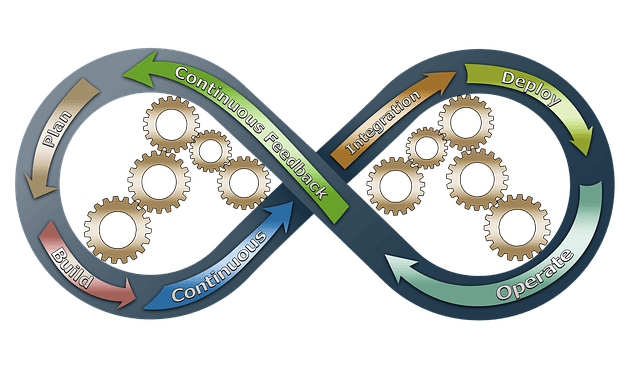
In a world of escalating competition, every company knows the critical importance of data. Indeed, the acquisition and processing of data allow many companies to differentiate themselves from their competitors. However, Big Data is not only used by marketing departments. More and more, HR departments are using it and proving its importance within the HR function. The emergence of new HR KPIs allows today to better measure productivity, the performance of an HR department, of a recruitment campaign, etc.
Furthermore, these KPIs are intended to implement new, more efficient, and less costly strategies in HR departments. To build relevant HR dashboards, the HR director needs to have a good knowledge of HR KPIs and keep a clear alignment with the company’s needs and strategies.
PeopleSpheres provides an overview of the various existing HR KPIs, their use and relevance, and the indicators that the HR function should prioritize.
Related articles:
HR Measurement: Everything You Need To Know About HR Metrics
A CHRO’s Guide to Formulating a powerful HR strategy
HR KPI: What is It?
The acronym KPI stands for Key Performance Indicator. It makes it possible to monitor or measure the effectiveness of a campaign or a strategy. The company must be able to collect precise and reliable data for a particular metric. By grouping different KPIs, the company can make decisions more quickly by justifying the decision with statistics. The performance indicator (KPI) is a tool for measuring the company’s performance.
The digitalization of business processes has not escaped the HR function. Indeed, HR departments know that they can now collect a lot of data thanks to HRIS software. To increase the efficiency of their actions, they define and implement numerous HR KPIs. These indicators are defined before launching a campaign or an HR strategy. Depending on the definition of the KPIs, HR departments can create dynamic and visual performance dashboards for the function within the company. Finally, it will be easier for them to calculate the ROI (return on investment) of an action or strategy.
The 5 Golden Rules of an HR KPI
Before choosing an HR KPI, you must first know several rules that define a good performance indicator. Here are 5 rules to follow:
Measurable
A performance indicator must be measurable. Nevertheless, it does not have to be a number. It can be in the form of a word cloud or verbatims to improve the progress of a meeting, for example. You must be able to measure your indicators accurately.
Actionable
Relevant indicators must enable the HR director to make decisions or implement new actions. For example, if the recruitment time is very long, the HR director must implement initiatives to reduce it.
Simple
A good HR KPI must be simple to build but also to understand. Indeed, the dashboard needs to be understandable for everyone: managers, HR directors, employees… Generally, KPIs are represented in the form of curves, diagrams, or pivot tables. With the development of tables and graphs, HR dashboards are visual and readable at a glance.
Reliable
For the indicator to be reliable, it must be based on data from reliable tools: HRIS, HR Core, CRM, etc. We cannot repeat it often enough: the digitalization and the use of Big Data are the future of the HR industry.
Controllable
A crucial and often forgotten rule is that a KPI must be controllable. In other words, it must highlight an outcome that the company has the power to improve. For example, the internal hiring rate can be managed by the HR department since it depends on the company’s strategy. However, the unemployment rate in the United States cannot be a KPI because the company has no control over unemployment.
It is also important to remember that an indicator often has a financial impact. It is, therefore, preferable to start by choosing two or three to avoid spreading yourself thin.
Here is an example of a dashboard from the PeopleSpheres HRIS:

The Benefits of HR KPIs for Your Company
By choosing relevant human resources management KPIs, you can set objectives upstream and over given periods (daily, monthly, quarterly, annually). By following the company’s HR policies, the HR department is more productive, and the profitability of the actions implemented more certain…
Other benefits can also be visible in the medium/long-term depending on the company:
More objective decision making
With the digitalization of HR services and consequently the reliability of the data, the decision-making and executive leaders can make smarter decisions quickly based on statistical data and other reports. The latter are then reassured about the decision to be taken, whether to maintain or cancel an action or a recruitment campaign. A decision can only be more objective when it is based on facts and numbers rather than on a feeling.
A better involvement and a stronger commitment from the employees
Is your employer brand at a low point and you don’t know how to improve it? Implementing KPIs on the performance of HR employees can be a solution. Creating a benevolent challenge between departments can be the solution. Set up performance indicators, individual and common objectives, and then offer feedback by teams. This initiative can increase employee commitment and therefore increase productivity. Assigning performance objectives to employees is a promising approach that leads to a more motivated and mobilized team.
A complete vision of the company’s health in terms of human resources
Since the dashboard regroups the company’s HR KPIs, it will be easier to have a complete vision of the department’s health. Indeed, a green indicator will be reassuring and will prove that the strategy in place is working. However, a red indicator should make the HR director take action. It is crucial to rebound quickly and modify the HR strategy that is not bearing any fruit. Finally, it will be important to understand the reasons for this red KPI: Is it a human reason, a lack of resources or tools? Nevertheless, the objective must be achievable.
More accurate budgeting
Each indicator has a financial impact on a project. Indeed, if a KPI is green, it means that there will probably be no additional costs or financial loss. On the other hand, a KPI in red indicates probable additional costs subsequently a loss for the company.
HR KPIs to Focus on
Depending on the size of the company, its activity, or its processes, it is possible to set up thousands of HR KPIs. Nevertheless, it is preferable to choose only a small number to start with (3 to 5 high quality KPIs). To help you make your choice, PeopleSpheres has created a categorization of the main HR KPIs for you. [Note that these are examples and are not meant to be a comprehensive list of all existing KPIs…].
KPIs related to recruitment
- Regarding recruitment, it is recommended to take into account the following indicators:
- Time to fill (from the identification of the need to the actual taking of the position).
- Recruitment costs (time, wages, headhunters, dedicated platforms…).
- Rate of selected candidates compared to the number of candidates proposed.
- Percentage of fixed-term, permanent, temporary, and freelance employees recruited (monthly, quarterly, and annual variations).
- Diversity ratio (gender, diplomas, level of education, etc.).

These HR recruitment KPIs allow for a better implementation of recruitment campaigns and consequently better management of the costs related to this critical task of the HR function.
KPIs for workforce management
The management and monitoring of the workforce are closely linked to the recruitment KPIs, as these define the company’s recruitment needs. Here are the main indicators in terms of workforce career management:
- Evolution of the number of training plans.
- Training success rate (physical and e-learning).
- Percentage of employees having attended at least one training course during the year.
- Overall rating of the various training courses offered (following a questionnaire for example).
- Evolution of the number of internal vacancies.
- Percentage of internal recruitments (following the internal mobility policy).
- Percentage of employees who have been offered a promotion in the last 12 months.
- Time and cost of internal recruitment.
- Absenteeism (to be crossed with the training rate, for example).
- Number of work-related accidents.
- Percentage of compensation increases over one or more years.
Talent Engagement KPIs
A good employer brand helps attract talent and develop it internally. This is especially true for “High Potential” talent. Here are some KPIs that can be useful:
- Percentage of “High Potentials” identified.
- Tools used to recruit these employees.
- Percentage of employees identified as “High Potential” after having undergone internal training.
- Turnover of these employees.
- Number of performance reviews conducted annually.
- Percentage of the training budget allocated to the development of strategic skills.
HR KPIs need to be defined in alignment with a campaign or strategy in order to build clear objectives for all employees. These objectives, unique to the company, allow the HR director to make objective decisions more quickly. HR management software and especially HRIS, such as PeopleSpheres with its software in SaaS model, are used to create ergonomic and more precise reports.
With this type of software, you can cross-reference the results of the various HR KPIs. The acquisition of data and its processing via limited, explicit, shared, and sustainable KPIs will contribute to a real competitive advantage.



-640x380.jpg)
